- Written by: Larry Blamire, Jacqueline Bryk, John Burke, Matthew Dawkins, Steffie de Vaan, Susann Hessen, Danielle, Lauzon, Myranda Kalis, John Kennedy, Bianca Savazzi, Hilary Sklar, Michael F. Tomasek Jr, and Eddy Webb
- Developed and Conceived by: Matthew Dawkins
- Storypath Line Developer: Eddy Webb
- Creative Director: Richard Thomas
- Editor: Dixie Cochran
- Art Director: Michael Chaney
- Interior Art: Larry Blamire, Brian Leblanc, Leo Albiero, Ken Meyer Jr, Andrea Payne, Eric Lofgren, Joel Biske, Aaron Riley, and Jeff Holt
- Cover Art: Larry Blamire
– – –
The scene opens on a beach, where a group of crab-people perform an awkward, shuffling dance around a hideous statue and call out praise to the great Mega Lobster.
A human cheerleader is chained to the statue. We follow her wide-eyed gaze out to sea where the Mega Lobster itself has just broken the surface.
Then! The camera snaps back as two heroic figures throw off unconvincing crab costumes and rush the scuttling crowd. One, a reporter, lays about himself with a loudspeaker, occasionally stopping to shout things like. “Extra, extra! Crabby abominations get what’s coming to ‘em!”
Beside him, a suited government agent adjusts her sunglasses and strides towards the high priest-crab, raising her experimental service weapon.
Before the chitinous horde can react to this sudden assault, the cheerleader rips herself free of the statue, taking several chunks of what are clearly painted polystyrene with her. She produces a tommy-gun from somewhere and opens fire on the crab cultists.
Out at sea, a grizzled, squid-scarred sea-captain guns the engine of her small fishing ship, accelerating to ramming speed. “That doohickie science-ray of yours better work Mr Scientist. ‘Cos what I see on the radar ain’t the crabsticks I ordered for lunch!”
The scientist in the back of the boat laughs wildly as he smacks a laser-cannon-like device repeatedly with a wrench. “The Lobster-Disintegratatron 3000 will work captain! It must work! For SCIENCE!”
That, in a nutshell, is They Came from Beneath the Sea! A roleplaying game of oceanic comedy, action and horror based on the B-movies of the 1950s. Weird monsters. Poorly made sets. Rubber costumes. Acting that was more enthusiastic than competent. Nonsensical catchphrases. It’s all here.
I love an role-playing game (RPG) with an original setting but I was never a particular fan of old B-movies so I honestly couldn’t say if I would have picked this game up if I wasn’t aware of who had made it. This game is the brainchild of Matthew Dawkins, known on YouTube as the Gentleman Gamer. He works as a game developer for Onyx Path, an RPG company whose podcast I have mentioned in a previous article on this very site. I’ve long been a fan of Dawkins’ work, so I was intrigued by this game and its kooky premise and have been looking forward to reviewing it for a couple of years now.
(Check out the trailer for the game on YouTube, it’s great fun.)
Chapter One: Introduction
The book is written in a conversational and practical style I enjoyed.
“Like aquatepillars, players are unpredictable and unruly, and we wouldn’t dream of dictating what you read first. Instead, go for what appeals and circle around to the rest later.”
You really get a sense of the nature of the game early on when one of the player characters (PCs) in the introductory example of play is described as having ‘suspected her husband of being a crab and beat him to death with a skillet’.
A key point to get your head around is, although the PCs are living through an actual alien invasion from the sea, the players themselves know this is a film, or at least that it behaves like a film. They can use various meta-abilities to take advantage of that.
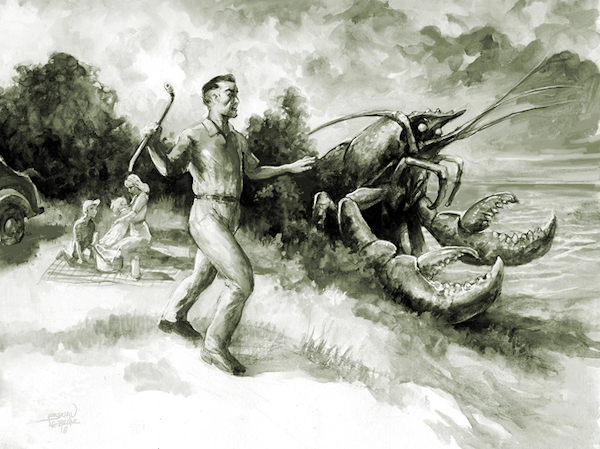
The PDF is fairly well laid out, with good explanations, repetition of key pieces of information and plenty of notes reminding you what chapters you can find certain concepts explained in. Though the repetition can occasionally make it tricky to navigate the bookmarks to find a full explanation of something. However, Cthulhu-be-praised, the table of contents is right at the start of the document, rather than being displaced by a piece of fiction.
There is a lot of short fiction spread through the book. Intentionally badly written, tongue-in-cheek stories intended to amuse the reader while establishing the tone of the game’s odd horror-comedy setting. There’s an ongoing conceit that all these stories are being sent to someone by an increasingly deranged and possibly dangerous scriptwriter. If, like me, you enjoy dry, absurdist, British humour, you should get a few chuckles out of reading through it all. The stories also all serve as ideas for adventures, which is great.
“The troubled teen pondered life as he sat brooding youthfully on Holeport’s moonlit pier. Something at water’s edge disrupted his thoughts of hotrods and he snatched it up. A shrimp. Man, what a trip.”
I did spot more typos than I would have expected from an Onyx Path product. Not nearly enough to make the text unreadable but enough missing words to draw my attention.
Chapter Two: Archetypes
Archetypes are like character classes or professions in other games. Each has their own unique set of abilities, defined as Tropes and Trademarks. We have the Everyman, the Mouth, the Scientist, the G-Man and the Survivor.
I was expecting more than five-character types, to be honest. Perhaps that was due to my lack of knowledge of the source material. Certainly, the game emphasises that Archetypes vary a lot. Let’s get into each one and you can decide for yourself.
The Everyman can be anyone from a soccer-mom to a security guard, a bar-owner to a baseball coach, a teenager to the town drunk. They are ordinary people who can do extraordinary things when their everyday existence is threatened. Their abilities include:
- Letting sheer determination carry them through to success, despite a complete lack of understanding of the task they’re trying to achieve.
- Always possessing the right tool for the job.
- Using their knowledge of strikes and union action to take on an alien organisation even more sinister than big corporations.
The Mouth is the person who wants to find out the truth and share it with the nation. Usually they’re journalists but an author, private investigator or celebrity would work too. Their abilities include:
- Flashing that press pass.
- Being particularly skilled at gathering information.
- Always being the centre of attention.
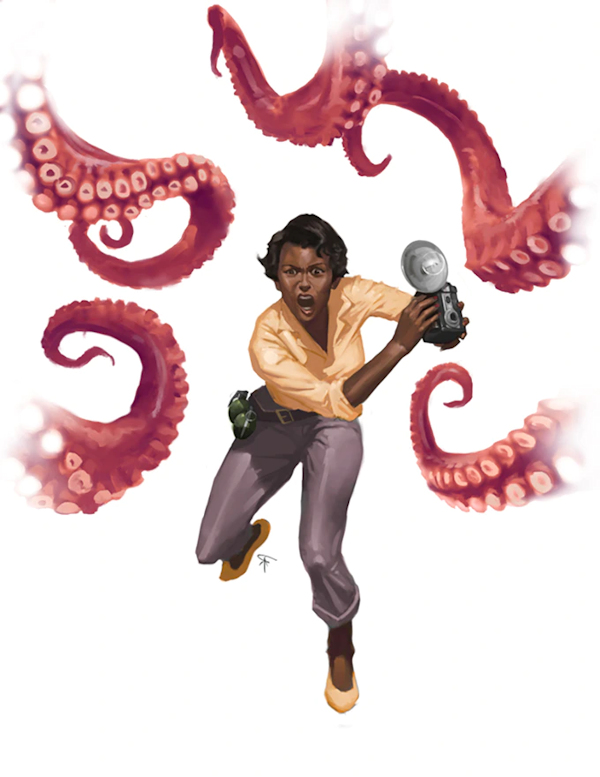
“Mouths are those who march into the beast’s maw just to ask if it has a quote.”
The G-man is a government agent—FBI, CIA, MIB or even local law enforcement. They are the people who solve crimes, stop invasions, and protect the public from dangerous things like rampaging coral-monsters or the truth. G-men can pick abilities such as:
- Wearing really menacing sunglasses.
- Losing tails.
- Embroiling other characters in shadowy conspiracies.
My favourite Archetype, the Scientist, is exactly what it says on the tin. But these aren’t the responsible journal-writing scientists of the real world. These are B-Movie scientists—obsessive, prone to dramatic shouting, possessed of labs full of bubbling chemicals and crackling wires. Their abilities include:
- Minor but beneficial mutations.
- Ignoring the laws of physics.
- Turning alien technology back against the invaders.
Finally, the Survivor is the person from the beginning of the movie, the one who escapes the initial attack and lives to tell the tale. Survivors can come from all walks of life, but their experiences have driven them to learn how to protect and fend for themselves in any situation. They can draw on tricks such as:
- Declaring retroactively that they’ve encountered this kind of situation before.
- Being too stubborn to die.
- Having a secret bunker.
The writers have definitely thought a lot about these character options. They’re not intended to cover all the bases; they’re intended to reproduce the experience of a B-Movie. There are descriptions of each Archetype’s lifestyle, appearance, and outlook too, to help you get into character.
It’s also a fairly modular system and would be easy to tinker with or swap around. Prompted by the book’s section on making your own Archetypes, I found myself thinking about how easy it would be to mix up the G-Man and Mouth to make a Politician or a Conspiracy Theorist. Or you could take parts of the Mouth and the Everyman and make a Soviet Infiltrator. (And so was born Perry Americanski, cheerful plumber-about-town and secret Russian spy.)
Chapter Three: Character Creation
This game uses the Storypath System, a muscular, elegant, and fairly adaptable system Onyx Path has turned to all sorts of uses, including the new edition of Scion. Storypath has a fairly mechanical, step-by-step process for building your character. If you’re familiar with the system you could probably knock a character together in around an hour. (Although I always struggle with the bit where you pick out nine different Connections for your character. I reached out to the Onyx Path Discord and was told by the community most people don’t bother with this step at character creation, instead they fill it in as the plot develops.)
The core of the process is picking three Paths, which then affect your Skills, Connections and powers. In this case, your Archetype (who you are), Origin (how you became that person), and Ambition (where you want to end up). Paths help you to make your character unique, although this book has a bunch of readymade templates for you to base your Paths on, e.g. Friendship or Suburbia.
They Came from Beneath the Sea! adds some unique abilities to the standard array of Skills, Attributes, and Connections, though they’re still linked to a character’s Paths.
Trademarks are short descriptive phrases like Wink to Camera, Mind like a Calculator, Subaquatica,or Iron Jaw. They’re linked to a Skill or Attribute and, once per session, they grant a bonus to it, if the player can explain how their Trademark applies to that particular roll. If the player passes a Trademarked roll, they get to change details in the scene as though they’d become the film’s director!
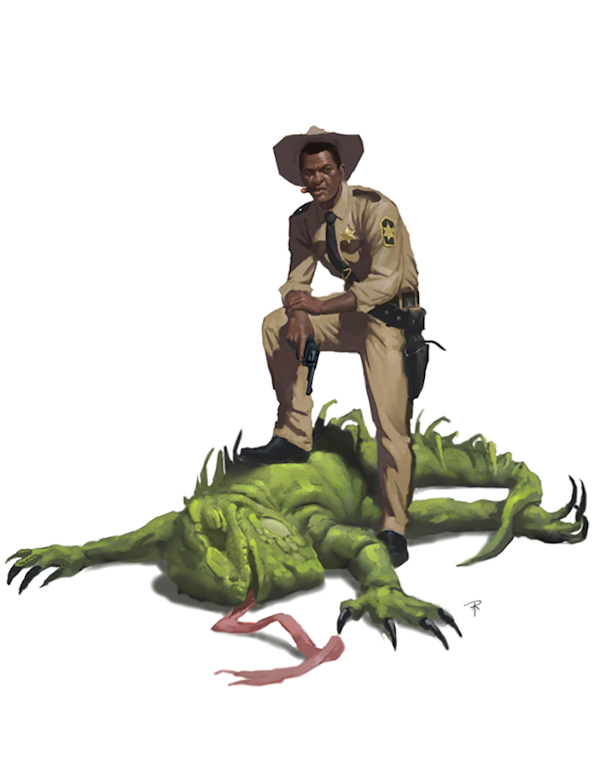
Tropes are a bit more complex. They are unique cinematic abilities like—having access to specialised equipment or funding, being able to ignore injuries, concealing oversized weapons in a skimpy outfit, or spotting clues with unlikely ease. These function pretty well as a method for making the PCs feel more like the protagonists of a B-Movie.
Quips are off the cuff remarks, jokes, witty asides and catchphrases. Each player starts with three and can say them aloud in order to get a bonus to a roll, as long as the rest of the table agrees their use of the Quip was funny.
Very helpfully, the main text is accompanied by two separate examples of character creation from start to finish (though neither of them help with Connections). This chapter as a whole encourages discussion at the table, so the players can come up with a good set of characters who complement each other.
“You probably aren’t making this character in a vacuum. And if you are, you should probably get some air.”
Overall, a helpful and useful chapter.
Chapter Four: Skills and Attributes
Another well laid out and practically explained chapter, with plenty of wry humour. (But not enough to get in the way.) I didn’t have any trouble understanding what each Skill or Attribute did.
The array of Skills is standard for Storypath and covers most situations, Aim, Survival, Technology, Science, Close Combat, Persuasion and so on. I like one Skill in particular, Enigmas, the art of deduction, puzzles and codebreaking. There’s no animal handling Skill but it could probably be covered by Survival or Empathy and perhaps animals don’t feature much in B-Movies anyway (training and housing them must be expensive).
Chapter Five: System
This chapter breaks down how the Storypath System works and how to use it to create a game that feels like a movie. Again, we get lots of helpful examples, e.g. of a hapless suburban husband’s attempts to escape or beat down an aquatic alien invader who has broken into his house.
I won’t go into a long explanation of the Storypath System here. Basically, it’s a dice pool system where you roll a number of D10s and count every die that rolls an 8, 9 or 10 as a Success (sometimes 7s are good too, depending on the game). It’s moderately crunchy in places but succeeds at giving the players lots of options, making their actions matter and keeping the action going even if the dice aren’t cooperating. If you can cope with D&D 5E, you can definitely cope with Storypath.
This book divides the game into three kinds of sequences, Action!; Investigation!; and Drama! In other words—physical challenges like wrestling a squid-man or piloting a ship through a storm, mental challenges like snooping around a crime scene or digging through an archive, and social encounters like interrogating a suspected brain-eater eel host or riling up a crowd to go and destroy the local temple of Dagon. It’s fairly neat and well explained, though I think it would take at least a couple of sessions for a new group to get the hang of all the bells and whistles. For example, the rules for mapping relationships and social interactions are more mechanised than in most games.
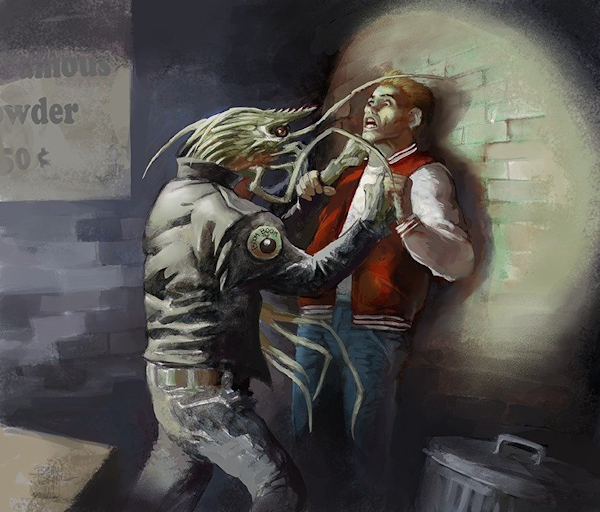
There’s a description of how to build antagonists without having to put together a whole character sheet (always good). There’s a chart to help explain this. But no matter how many times I reread this section I couldn’t work out if the chart was supposed to be for an antagonist’s entire dice pool or just their Skills.
One brilliant innovation in this section is the way damage is dealt with. RPGs usually treat damage in one of two ways. Games like D&D have characters remaining perfectly functional right up until they lose their last Hit Point (or whatever), then they keel over unconscious and start bleeding to death. Other games like Vampire: The Masquerade or Zweihänder have characters taking wounds, conditions or stat losses that impair them in some way, leading to the dreaded death spiral, i.e. the more damage you take the less effective you are and the more likely you are to take more damage.
They Came from Beneath the Sea! reverses the death spiral. The more injuries your character takes, the more bonus dice they get to roll, right up until the point when they take fatal damage and trigger a dramatic death scene. This is genius because it really captures the feel of action movies. Think of films like Die Hard, Crank, or John Wick, where the hero gets stabbed or shot or burned but doesn’t slow down for more than a moment. They just grunt a bit then carry on completely unimpaired, mowing down even more foes than before.
It also encourages players to be more reckless with their characters, who are, after all, heroes in a movie!
Chapter Six: Cinematic Powers
One thing core to Storypath is the idea of Stunts. If you get more Successes than you need to pass a roll, you can purchase Stunts that do things like inflict extra damage or give you an advantage over your opponent. This game really leans into the idea of Stunts as a way to explore the medium of B-Movies.
Force an alien to lose their next turn because they’re so stunned by how easily you overcame their wicked technology. Terrify the customers of a rowdy bar with a glare and a curt one-liner. Get in an extra attack if any aquatic abomination dares to strike at you. It’s all fun stuff. Characters who have had an Encounter (been attacked or affected by thinking aliens or their technology), can use some much weirder Stunts. Shaking off mutagens through sheer force of stubborn DNA. Mild telekinesis. And, of course, the mighty Pyro-Punch! Incidentally, there’s a pretty in-depth description of what it means to be an Encountered character, which I found quite interesting.
Each Archetype gets their own set of Cinematic Stunts as well, which is a nice touch. I really like the Scientist Stunts. Turn alien tech to your own ends. Make bullets that are toxic to your inhuman foes. Craft a surprisingly effective counter to whatever the aliens are doing in the time it would take a real scientist to write the first draft of their initial research proposal. It really fits with the role of a scientist in an actual B-Movie.
I also enjoyed the Everyman’s ability to master vehicles after a suitable length of time working on one (in a montage scene, no doubt). And the G-Man’s ability to steamroll local law enforcement by having someone high-up in the government call them and tell them to get with the programme. And the Mouth’s ability to pull off the most ridiculous disguises. It’s all fun and flavourful.
While Stunts put the spotlight on individual PCs, Cinematics focus on the set, the supporting crew and cast, the writers, and the director. They let the players use the tropes of badly made B-Movies to guide or alter the plot of the game. By spending Rewrites (a shared resource generated by failed rolls and a few other things), players can create all sorts of effects. They can:
- Take over the speech of minor characters.
- Call in a stuntman or understudy with different abilities to a PC, e.g. a physically strong and agile person who takes over from the weedy Scientist and successfully escapes a rampaging giant squid, only to tap out in favour of the main actor as soon as the character needs to speak.
- Smash through a cheap cardboard set.
- Simply fail to die when the dice say they should, either because the fans love their character too much or because a sidekick jumped in front of the shot.
- Restart a scene because they don’t like how it played out the first time.
- Incite a The Shape of Water storyline.
- Or even escape an impossible situation by straight-up skipping to the next scene, leaving the characters to drop vague hints about how they survived.
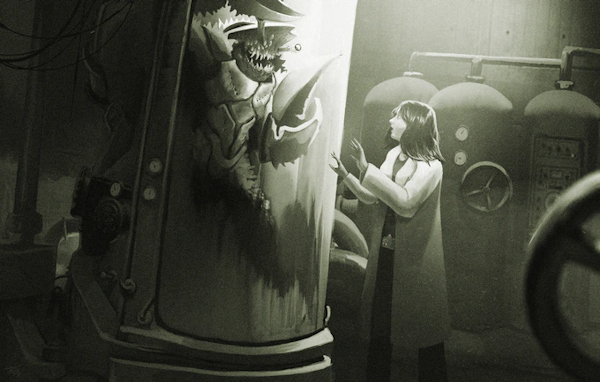
I can really see groups having a lot of fun with these abilities. It’s definitely a cool, unique selling point for the game.
We also get a more in-depth explanation of Quips, which are split into six Decks with names like Quip Your Griping, Please Enjoy This Great Portent, and The Flirtation. These are clearly dear to the writers’ hearts and I can see how important they are to the setting. A key point is successfully repeating the same Quip over and over grants increasing bonuses, effectively rewarding a PC for having a catchphrase.
Now for a gripe. Players of this game need to deal with Tropes, Trademarks, Quips, Cinematics, four kinds of Stunts, Connections and Contacts. I was just thinking this was too much of a good thing and perhaps they could have combined one or two of these powers together, when I ran across a note in the book titled, “It’s A Lot To Take In”. This note admitted the game has a lot going on and offers suggestions on the bits you can cut out if you want to streamline it. I’d have preferred the writers to have completed the thought and cut something out themselves. But fair play to them for acknowledging it in the first place and giving us optional workarounds.
I should add this game likely works best when you’re all in a room together, riffing on each other’s jokes. Particularly because Quips and Cinematics are designed to be printed out on cards so players can have the satisfaction of slapping them down onto the table to activate them, which will also help remind players to use those abilities. Now, Onyx Path has a slow and steady development cycle and could not have anticipated we’d all be huddled in our homes at this point, socialising and roleplaying through our computers. I look forward to the day when I can play this game to its full potential.
Chapter Seven: The Human World Invaded!
This chapter describes the game’s setting—an idyllic 1950s USA being menaced by maritime horrors. This is a world of cute small towns, growing prosperity, rock music, drive-ins and dances, and really good milkshakes.
The writers make no bones about the fact they’re presenting a rose-tinted view of the 1950s as standard for the setting. There is also a run-down of the darker side of the decade—racism and civil rights, McCarthyism and the House of Unamerican Activities, the Red Scare and the threat of nuclear war.
Then we shift seamlessly into weirdness. Stalin has returned from the dead with an eel in his head. US nuclear testing has awoken and/or enraged a number of undersea civilisations and monsters. Japan is surprisingly prepared for the threat of giant beasts from the deep. We get preliminary discussions of all sorts of threats from the sea here but I’ll discuss those in the next chapter.

A final note on this chapter. This game, like all Onyx Path properties I’ve encountered, is dedicated to equal representation. Yes, there likely weren’t any openly gay FBI agents in 1950s America, but you can play one if you want. Or a female scientist (who did exist in the films and reality of the time). Or a grizzled gender-neutral military veteran. I appreciate and respect this approach, after all, we’re fighting off giant crabs, let’s not get bogged down in historical accuracy when it comes to picking out our characters.
Chapter Eight: Threats
[Spoiler Warning: Players beware! There are plot spoilers in this section.]
For me, a new RPG setting lives and dies on its bestiary. Now, you might think that umpteen different kinds of fish-people would get boring after a while.
But the truth is our oceans are home to an incredibly diverse variety of creatures, many of which are terrifying. The writers of this book have plundered the very depths to bring us a wildly weird and wonderful set of marine species to battle. Shark thugs! A giant clam! Evil coral! Living water! Teenage shrimp! Paramilitary dolphins! Horrible, acidic caterpillar things!
“Suspended technology is entirely slime-based.”
“They are, however, vulnerable to boiling water and small hammers.”
“…a feeding proboscis that extends up to 10 times the creature’s body size.”
Other threats draw more on classic sci-fi tropes rather than sea-life. Invaders from the future, robots bent on replacing humanity, grey aliens, the mysterious ‘glowing people’ who abduct humans for unknown reasons. (I love the artwork of the glowing people, it’s like a disco has come to life and gone on the rampage.)
The aliens are divided into five broad types, each of which is opposed by a specific Archetype. Destroyers just want to wipe out humanity or are too stupid to do more than kill and eat. Enslavers are here to dominate our minds through various nefarious means. Invaders may not wish to wipe out humanity completely but they’re certainly intent on conquest. Primordials have been around so long that getting rid of us is more like pest control than warfare to them. Spies either work for other powers or haven’t yet enacted their dastardly plans, for now they’re intent on infiltrating human society. A sixth category, Terrestrial Threats, covers human collaborators from smugglers, to cultists, to scientists who might actually be good guys.
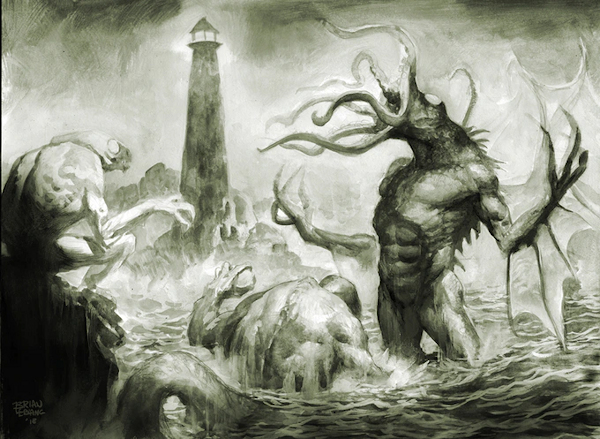
Every species offers at least one plot hook and between them you can find a wide range of different adventure ideas, each of which feels like a film. You can flee from a hungry aquatepillar. You can attempt to uncover and overcome the dastardly infiltrations of the octopoid thaumocs. You can negotiate a form of peace with the atlantoids or F.I.S.H.
- The crab people offer a hilarious take on a Body Snatchers style scenario. The brain-eater eels are less comedic, though still quite quirky.
- The kelp-men intend to use mind control rays combined with tainted tv dinners to turn the human population into helpless slaves.
- The titanic centopus is all but unstoppable. But if it eats you, you’ll find yourself stranded inside its body, wandering through digestive tracts and arteries while trying to fight off the cult of survivors who lurk within.
- There’s even a man made of uranium who is only interested in eating nuclear power plants. Unfortunately, once he’s eaten enough, he will detonate with nuclear force before returning to his age-old slumber.
There are some interesting relationships between the different species of alien. Some of them hate each other more than they hate humanity and may even ally with the land-dwellers to destroy the true foe. One or two groups are presented slightly differently elsewhere in the book than they appear here. Possibly intentionally.
Overall, a top-notch bestiary. 10 out of 10, would bestiary again.
[End Spoilers]
Chapter Nine: Playing the Director
The obligatory section about how to run an RPG is fairly brief. (Not a problem as far as I’m concerned, considering how much good and practical advice is in the book as a whole.) It does have some interesting ideas about the kind of film your adventure is supposed to be. Is it an art film, complete with random political diatribes and skeletons smoking cigarettes? Or a sexed up, gore-splattered, exploitation flick?
Pleasingly, this section comes with not one but two starter scenarios. One is a one-shot intro to the game and the other is a more advanced sandbox.
The sandbox is “Small Wonders: The Delaware Beaches”. It paints a picture of a coastline swarming with all sorts of competing threats and factions, many of which the locals are at least partially aware of. (In one area, human and non-human children play together in relative harmony.) Different neighbourhoods offer different flavours of gameplay. It could be a fairly straightforward invasion scenario where you fight off nightly attacks by angry crustaceans. Or a more insidious infiltration plot you need to uncover. Or a diplomatic negotiation with the aquatic humanoids living in the bay. You could bounce between all three or try to ally with one faction against another.
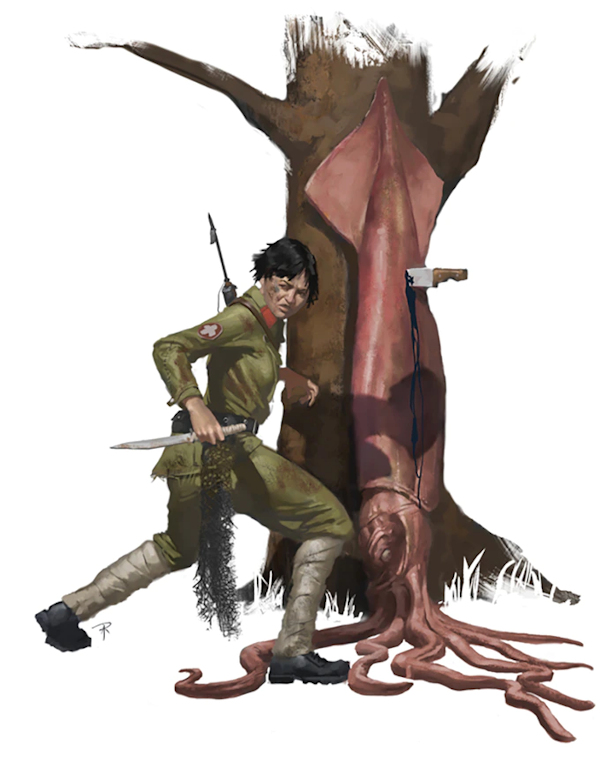
(Amusingly, the local glowing people have found religion and like to attend sermons at the Episcopalian church in town. They still kidnap tourists though.)
There are also some nice bits of local character. The family beach. The wilder bar-district where people go to drink and hook up. An isolated little town full of fisher-folk who are almost as distrustful of human visitors as they are of menaces from beneath the waves.
There are plenty of ‘faces’ such as bar owners and resistance leaders, as well as alien infiltrators. And no shortage of potential flashpoints that could exacerbate conflict between humans and non-humans.
There’s good representation for different groups too. A female resistance unit. Queer communities. People of different ethnic origins. Contemporary prejudice against these groups isn’t glossed over in the text but it’s up to you how much it intrudes on your gameplay.
The intro scenario is “A Slippery Conspiracy”; a creepy scenario set in a small town in Hawaii. It’s split into five acts and provides good, step by step advice on how to play them out. There’s also very practical advice on topics such as keeping up with the players if they go haring off on a tangent. Complete with ready-made NPCs, PCs, information on the local area and ideas on follow-up adventures, it’s a great resource for novice GMs.
Conclusion
They Came from Beneath the Sea! gave me a sense of freedom and fun. The feeling I could just relax into playing a larger-than-life character in a kitschy setting with alien threats that could be as ludicrous as I wanted them to be. There’s quite a bit to get into with the rules but I don’t think they’re complex for the sake of complexity; they’ve been carefully designed to simulate that weird B-Movie aesthetic and they all seem fun. I’m itching to test out the Cinematics and the crazier Stunts. I would absolutely play it as a chill-out game with friends. In fact, I’m tempted to run extra games with as many different friends as possible, just to see what they all do with it.
If you like B-Movies and RPGs then you have no reason not to buy this game. If B-Movies aren’t your thing, I would still recommend you look into this game, maybe check out some Let’s Plays online. It’s fun and funny and lovingly crafted and you get in-game rewards for making your friends laugh or wrecking the plot with metagame shenanigans.
Disclaimer: I received a digital review copy of this game in return for an honest review.


